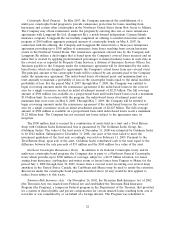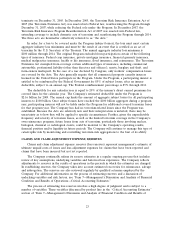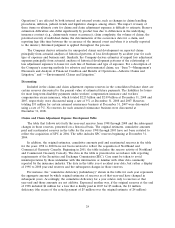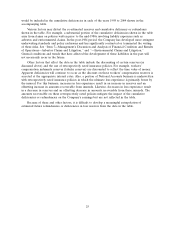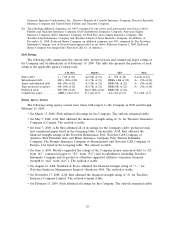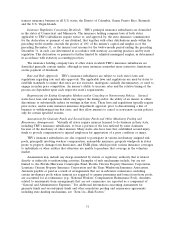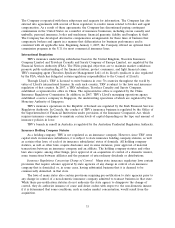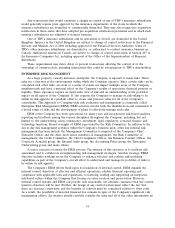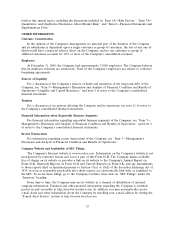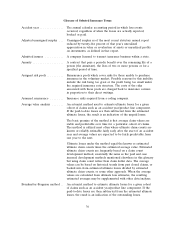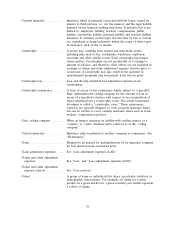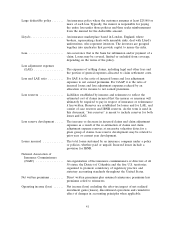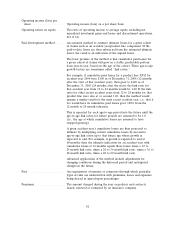Travelers 2008 Annual Report Download - page 44
Download and view the complete annual report
Please find page 44 of the 2008 Travelers annual report below. You can navigate through the pages in the report by either clicking on the pages listed below, or by using the keyword search tool below to find specific information within the annual report.Insurance Regulatory Information System. The National Association of Insurance Commissioners
(NAIC) developed the Insurance Regulatory Information System (IRIS) to help state regulators
identify companies that may require special attention. Financial examiners review annual statements
and key financial ratios based on year-end data. These ratios assist state insurance departments in
executing their statutory mandate to oversee the financial condition of insurance companies. Each ratio
has an established ‘‘usual range’’ of results. A ratio result falling outside the usual range of IRIS ratios,
however, is not considered a failing result; rather, unusual values are viewed as part of the regulatory
early monitoring system. Furthermore, in some years, it may not be unusual for financially sound
companies to have several ratios with results outside the usual ranges. Generally, an insurance company
will become subject to regulatory scrutiny if it falls outside the usual ranges of four or more of the
ratios.
Based on preliminary 2008 IRIS ratios calculated by the Company, The Travelers Indemnity
Company and The Standard Fire Insurance Company had results outside the normal range on one
IRIS ratio, due to the amount of dividends received from their respective subsidiaries. Travelers
Casualty and Surety Company of America had results outside the normal range for one IRIS ratio due
to reduced dividends paid to its parent company in 2008. First Trenton Indemnity Company had results
outside the normal range for two IRIS ratios due to increased dividends paid to its parent company in
2008. Travelers Auto Insurance Co. of New Jersey had results outside the normal range for one IRIS
ratio due to the receipt of a capital contribution from its parent company. Several additional companies
had results outside the normal range for one IRIS ratio due to increased direct written premiums in
these companies. In 2007, St. Paul Mercury Insurance Company had results outside the normal range
on four of the IRIS ratios, and St. Paul Guardian Insurance Company had results outside the normal
range on three of the IRIS ratios. These results were due to these companies becoming Travelers
Reinsurance Pool participants in 2007. Previously, these companies had been 100% reinsured by The
Travelers Indemnity Company, one of the Travelers Reinsurance Pool participants. In conjunction with
their new participation, St. Paul Mercury Insurance Company and St. Paul Guardian Insurance
Company received capital contributions of $30 million and $10 million, respectively, from their parent
company, St. Paul Fire and Marine Insurance Company, in 2007.
Management does not anticipate regulatory action as a result of the 2008 IRIS ratio results. In all
instances in prior years, regulators have been satisfied upon follow-up that no regulatory action was
required. It is possible that similar results could occur in the future.
Risk-Based Capital (RBC) Requirements. The NAIC has an RBC requirement for most property
and casualty insurance companies. The RBC requirement determines minimum capital requirements
and is intended to raise the level of protection for policyholder obligations. Under laws adopted by
individual states, insurers having total adjusted capital less than that required by the RBC calculation
will be subject to varying degrees of regulatory action, depending on the level of capital inadequacy.
The formulas have not been designed to differentiate among adequately capitalized companies that
operate with higher levels of capital. Therefore, it is inappropriate and ineffective to use the formulas
to rate or to rank these companies. At December 31, 2008, all of TRV’s insurance subsidiaries had
total adjusted capital in excess of the RBC requirement.
Investment Regulation. Insurance company investments must comply with applicable laws and
regulations which prescribe the kind, quality and concentration of investments. In general, these laws
and regulations permit investments in federal, state and municipal obligations, corporate bonds,
preferred and common equity securities, mortgage loans, real estate and certain other investments,
subject to specified limits and certain other qualifications. At December 31, 2008, the Company was in
compliance with these laws and regulations.
Agent and Broker Compensation. As part of industry-wide investigations, the Company received
subpoenas and written requests for information from a number of regulators. The areas of pending
inquiry addressed to the Company include the method by which brokers and agents are compensated.
32


